+ Open data
Open data
- Basic information
Basic information
| Entry | Database: PDB / ID: 6oet | |||||||||||||||||||||||||||||||||
|---|---|---|---|---|---|---|---|---|---|---|---|---|---|---|---|---|---|---|---|---|---|---|---|---|---|---|---|---|---|---|---|---|---|---|
| Title | Cryo-EM structure of mouse RAG1/2 STC complex | |||||||||||||||||||||||||||||||||
 Components Components |
| |||||||||||||||||||||||||||||||||
 Keywords Keywords | RECOMBINATION/DNA / V(D)J recombination / DNA Transposition / RAG / SCID / RECOMBINATION / RECOMBINATION-DNA complex | |||||||||||||||||||||||||||||||||
| Function / homology |  Function and homology information Function and homology informationmature B cell differentiation involved in immune response / B cell homeostatic proliferation / negative regulation of T cell differentiation in thymus / DN2 thymocyte differentiation / pre-B cell allelic exclusion / positive regulation of organ growth / regulation of behavioral fear response / V(D)J recombination / negative regulation of T cell apoptotic process / phosphatidylinositol-3,4-bisphosphate binding ...mature B cell differentiation involved in immune response / B cell homeostatic proliferation / negative regulation of T cell differentiation in thymus / DN2 thymocyte differentiation / pre-B cell allelic exclusion / positive regulation of organ growth / regulation of behavioral fear response / V(D)J recombination / negative regulation of T cell apoptotic process / phosphatidylinositol-3,4-bisphosphate binding / histone H3K4me3 reader activity / negative regulation of thymocyte apoptotic process / phosphatidylinositol-3,5-bisphosphate binding / regulation of T cell differentiation / organ growth / positive regulation of T cell differentiation / T cell lineage commitment / B cell lineage commitment / phosphatidylinositol-3,4,5-trisphosphate binding / T cell homeostasis / T cell differentiation / protein autoubiquitination / phosphatidylinositol-4,5-bisphosphate binding / phosphatidylinositol binding / thymus development / B cell differentiation / RING-type E3 ubiquitin transferase / visual learning / ubiquitin-protein transferase activity / ubiquitin protein ligase activity / T cell differentiation in thymus / chromatin organization / endonuclease activity / histone binding / DNA recombination / adaptive immune response / sequence-specific DNA binding / Hydrolases; Acting on ester bonds / defense response to bacterium / chromatin binding / protein homodimerization activity / DNA binding / zinc ion binding / nucleoplasm / metal ion binding / identical protein binding / nucleus Similarity search - Function | |||||||||||||||||||||||||||||||||
| Biological species |   | |||||||||||||||||||||||||||||||||
| Method | ELECTRON MICROSCOPY / single particle reconstruction / cryo EM / Resolution: 3.4 Å | |||||||||||||||||||||||||||||||||
 Authors Authors | Chen, X. / Cui, Y. / Zhou, Z.H. / Yang, W. / Gellert, M. | |||||||||||||||||||||||||||||||||
| Funding support |  United States, 1items United States, 1items
| |||||||||||||||||||||||||||||||||
 Citation Citation |  Journal: Nat Struct Mol Biol / Year: 2020 Journal: Nat Struct Mol Biol / Year: 2020Title: How mouse RAG recombinase avoids DNA transposition. Authors: Xuemin Chen / Yanxiang Cui / Huaibin Wang / Z Hong Zhou / Martin Gellert / Wei Yang /  Abstract: The RAG1-RAG2 recombinase (RAG) cleaves DNA to initiate V(D)J recombination, but RAG also belongs to the RNH-type transposase family. To learn how RAG-catalyzed transposition is inhibited in ...The RAG1-RAG2 recombinase (RAG) cleaves DNA to initiate V(D)J recombination, but RAG also belongs to the RNH-type transposase family. To learn how RAG-catalyzed transposition is inhibited in developing lymphocytes, we determined the structure of a DNA-strand transfer complex of mouse RAG at 3.1-Å resolution. The target DNA is a T form (T for transpositional target), which contains two >80° kinks towards the minor groove, only 3 bp apart. RAG2, a late evolutionary addition in V(D)J recombination, appears to enforce the sharp kinks and additional inter-segment twisting in target DNA and thus attenuates unwanted transposition. In contrast to strand transfer complexes of genuine transposases, where severe kinks occur at the integration sites of target DNA and thus prevent the reverse reaction, the sharp kink with RAG is 1 bp away from the integration site. As a result, RAG efficiently catalyzes the disintegration reaction that restores the RSS (donor) and target DNA. | |||||||||||||||||||||||||||||||||
| History |
|
- Structure visualization
Structure visualization
| Movie |
 Movie viewer Movie viewer |
|---|---|
| Structure viewer | Molecule:  Molmil Molmil Jmol/JSmol Jmol/JSmol |
- Downloads & links
Downloads & links
- Download
Download
| PDBx/mmCIF format |  6oet.cif.gz 6oet.cif.gz | 469.3 KB | Display |  PDBx/mmCIF format PDBx/mmCIF format |
|---|---|---|---|---|
| PDB format |  pdb6oet.ent.gz pdb6oet.ent.gz | 356.3 KB | Display |  PDB format PDB format |
| PDBx/mmJSON format |  6oet.json.gz 6oet.json.gz | Tree view |  PDBx/mmJSON format PDBx/mmJSON format | |
| Others |  Other downloads Other downloads |
-Validation report
| Summary document |  6oet_validation.pdf.gz 6oet_validation.pdf.gz | 789.2 KB | Display |  wwPDB validaton report wwPDB validaton report |
|---|---|---|---|---|
| Full document |  6oet_full_validation.pdf.gz 6oet_full_validation.pdf.gz | 813.7 KB | Display | |
| Data in XML |  6oet_validation.xml.gz 6oet_validation.xml.gz | 55.8 KB | Display | |
| Data in CIF |  6oet_validation.cif.gz 6oet_validation.cif.gz | 87.8 KB | Display | |
| Arichive directory |  https://data.pdbj.org/pub/pdb/validation_reports/oe/6oet https://data.pdbj.org/pub/pdb/validation_reports/oe/6oet ftp://data.pdbj.org/pub/pdb/validation_reports/oe/6oet ftp://data.pdbj.org/pub/pdb/validation_reports/oe/6oet | HTTPS FTP |
-Related structure data
| Related structure data |  20037MC  6oesC C: citing same article ( M: map data used to model this data |
|---|---|
| Similar structure data |
- Links
Links
- Assembly
Assembly
| Deposited unit | 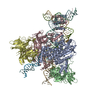
|
|---|---|
| 1 |
|
- Components
Components
-V(D)J recombination-activating protein ... , 2 types, 4 molecules ACBD
| #1: Protein | Mass: 119388.352 Da / Num. of mol.: 2 / Mutation: E962Q Source method: isolated from a genetically manipulated source Source: (gene. exp.)   Homo sapiens (human) Homo sapiens (human)References: UniProt: P15919, Hydrolases; Acting on ester bonds, RING-type E3 ubiquitin transferase #2: Protein | Mass: 59138.410 Da / Num. of mol.: 2 Source method: isolated from a genetically manipulated source Source: (gene. exp.)   Homo sapiens (human) / References: UniProt: P21784 Homo sapiens (human) / References: UniProt: P21784 |
|---|
-DNA chain , 5 types, 6 molecules FIJGLM
| #3: DNA chain | Mass: 15521.905 Da / Num. of mol.: 1 / Source method: obtained synthetically / Source: (synth.)  | ||||||
|---|---|---|---|---|---|---|---|
| #4: DNA chain | Mass: 4576.958 Da / Num. of mol.: 2 / Source method: obtained synthetically / Source: (synth.)  #5: DNA chain | | Mass: 18761.963 Da / Num. of mol.: 1 / Source method: obtained synthetically / Source: (synth.)  #6: DNA chain | | Mass: 9138.938 Da / Num. of mol.: 1 / Source method: obtained synthetically / Source: (synth.)  #7: DNA chain | | Mass: 12655.191 Da / Num. of mol.: 1 / Source method: obtained synthetically / Source: (synth.)  |
-Non-polymers , 2 types, 4 molecules 


| #8: Chemical | | #9: Chemical | |
|---|
-Details
| Has protein modification | N |
|---|
-Experimental details
-Experiment
| Experiment | Method: ELECTRON MICROSCOPY |
|---|---|
| EM experiment | Aggregation state: PARTICLE / 3D reconstruction method: single particle reconstruction |
- Sample preparation
Sample preparation
| Component | Name: RAG1/2 strand transfer complex / Type: COMPLEX / Entity ID: #1-#7 / Source: MULTIPLE SOURCES |
|---|---|
| Molecular weight | Units: MEGADALTONS / Experimental value: YES |
| Source (natural) | Organism:  |
| Buffer solution | pH: 7.4 |
| Specimen | Embedding applied: NO / Shadowing applied: NO / Staining applied: NO / Vitrification applied: YES |
| Specimen support | Details: unspecified |
| Vitrification | Cryogen name: ETHANE |
- Electron microscopy imaging
Electron microscopy imaging
| Experimental equipment |  Model: Titan Krios / Image courtesy: FEI Company |
|---|---|
| Microscopy | Model: FEI TITAN KRIOS |
| Electron gun | Electron source:  FIELD EMISSION GUN / Accelerating voltage: 300 kV / Illumination mode: FLOOD BEAM FIELD EMISSION GUN / Accelerating voltage: 300 kV / Illumination mode: FLOOD BEAM |
| Electron lens | Mode: BRIGHT FIELD |
| Image recording | Electron dose: 45 e/Å2 / Film or detector model: GATAN K2 SUMMIT (4k x 4k) |
- Processing
Processing
| Software | Name: PHENIX / Version: 1.14_3260: / Classification: refinement | ||||||||||||||||||||||||
|---|---|---|---|---|---|---|---|---|---|---|---|---|---|---|---|---|---|---|---|---|---|---|---|---|---|
| EM software | Name: PHENIX / Category: model refinement | ||||||||||||||||||||||||
| CTF correction | Type: PHASE FLIPPING AND AMPLITUDE CORRECTION | ||||||||||||||||||||||||
| 3D reconstruction | Resolution: 3.4 Å / Resolution method: FSC 0.143 CUT-OFF / Num. of particles: 68085 / Symmetry type: POINT | ||||||||||||||||||||||||
| Refine LS restraints |
|
 Movie
Movie Controller
Controller
















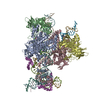
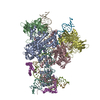
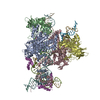

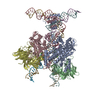
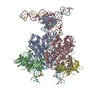

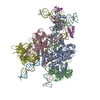
 PDBj
PDBj











































